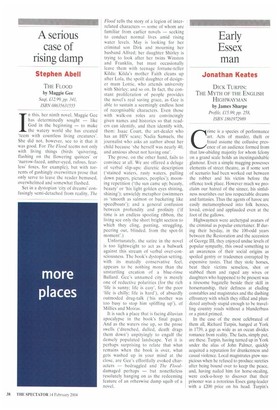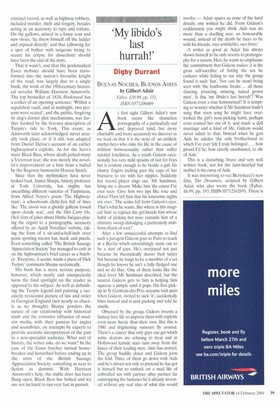Early Essex man
Jonathan Keates
DICK TURPIN: THE MYTH OF THE ENGLISH HIGHWAYMAN by James Sharpe Profile, £15.99, pp. 258, ISBN 1861972989 Crime is a species of performance art. Acts of murder, theft or fraud assume the collusive presence of an audience formed from that law-abiding majority for whom felony on a grand scale holds an inextinguishable glamour. Even a simple mugging possesses elements of street theatre, as if some sort of scenario had been worked out between the robber and his victim before the offence took place. However much we proclaim our hatred of the sinner, his sinfulness nourishes our less respectable dreams and fantasies. Thus the agents of havoc are easily metamorphosed into folk heroes, loved, envied and applauded even at the foot of the gallows.
Highwaymen were archetypal avatars of the criminal as popular entertainer. If during their heyday, in the 100-odd years between the Restoration and the accession of George III, they enjoyed undue levels of popular sympathy, this owed something to an awareness of their social origins as spoiled gentry or tradesmen corrupted by expensive tastes. That they stole horses, beat their victims senseless, shot or stabbed them and raped any wives or daughters who happened to be present was a tiresome bagatelle beside their skill in horsemanship, their deftness at eluding constables and magistrates and the dashing effrontery with which they rifled and plundered anybody stupid enough to be travelling country roads without a blunderbuss or a pistol primed.
In the case of the most celebrated of them all, Richard Turpin, hanged at York in 1739, a gap as wide as an ocean divides romance from reality. The facts, simply put, are these. Turpin, having turned up in York under the alias of John Palmer, quickly acquired a reputation for drunkenness and casual violence. Local magistrates grew suspicious when he refused to produce sureties after being bound over to keep the peace, and, having nailed him for horse-stealing, were cock-a-hoop to discover that their prisoner was a notorious Essex gang-leader with a L200 price on his head. Turpin's
criminal record, as well as highway robbery, included murder, theft and forgery, besides acting as an accessory to rape and torture. On the gallows, attired in a fancy coat and new shoes, 'he threw himself off the ladder and expired directly' and that (allowing for a spot of bother with surgeons trying to secure his corpse for dissection) should have been the end of the story. That it wasn't, and that the pockmarked Essex mobster should have been transformed into the nation's favourite knight of the road, was largely due to a single book, the work of the 19th-century historical novelist William Harrison Ainsworth. The top bestseller of 1834, Rookwood has a corker of an opening sentence: 'Within a sepulchral vault, and at midnight, two persons were seated', and the public, forgiving its dog's-dinner plot mechanisms, was further hooked by the bravura description of Turpin's ride to York. This event, as Ainsworth later acknowledged, never actually took place, or if it did, was adapted from Daniel Defoe's account of an earlier highwayman's exploits. As for the hero's mare Black Bess, whose death jerked many a Victorian tear, she was merely the novelist's improvement on a hint from a ballad by the Regency humourist Horace Smith. Since then the mythmakers have never looked back. James Sharpe, history professor at York University, has mighty fun unearthing different varieties of Turpiniana, from Alfred Noyes's poem 'The Highwayman', a schoolroom cliche-fest full of lines like 'The moon was a ghostly galleon tossed upon cloudy seas', and the film Cany On, Dick (lots of jokes about Hattie Jacques playing the organ) to a pornographic accessory offered by an 'Adult Novelties' website, taking the form of a six-and-a-half-inch erect penis sporting tricorn hat, mask and pistols. Even something called 'The British Sausage Appreciation Society' has managed to cash in on the highwayman's brief career as a butcher. 'Everyone, it seems, wants a piece of Dick Turpin,' comments Sharpe sardonically. His book has a more serious purpose, however, which neatly and unexpectedly turns the final spotlight on the reader as opposed to the subject. As well as debunking the Turpin legend and painting a succinctly revisionist picture of law and order in Georgian England (not nearly so chaotic as we thought) Sharpe ponders the nature of our relationship with historical truth and the corrosive influence of modern media, with their passion for angles and soundbites, on attempts by experts to provide accurate interpretation of the past to a non-specialist audience. What sort of history, the writer asks, do we want? In the case of the Essex butcher turned housebreaker and horsethief before ending up in the arms of the British Sausage Appreciation Society, something as near to fiction as dammit. With Harrison Ainsworth's help, the stable door has been flung open, Black Bess has bolted and we are not inclined to run very fast in pursuit.



































































 Previous page
Previous page